Call for proposals
- Call for Proposal for ASTE
- How to Prepare for ASTE Observing Proposals
- Instrumentation Overview
How to prepare for ASTE observing proposals
November 1, 2017
Here we have several notes before planning and preparing your observing proposals for ASTE. Please carefully read the document below.
1. Targets for observations
We recommend conducting observations above the elevation angle (EL) of 30 deg. It means that a source with a declination < +37 deg will be a target for ASTE. Pointing accuracy may be significantly degraded for EL < 30 deg. See Fig. 1 for the time-elevation diagram in ASTE for various declination angles of sources.
Observations will be done during “night time”. Here we define the night time as follows: from 1 hour later of the sun set, to 2 hours later of the sun rise. Note that frequent pointing/intensity calibrations may be necessary for observations after sun rise, because a rapid change of the ambient temperature after sun rise may cause a significant variation of the telescope performance. We will have no observations during day time due to degradation of the telescope performance.
The night time at the ASTE site is listed in Table 1. See Fig. 2 for the azimuth-elevation diagram for several selected standard/calibration sources and the Sun.

Fig.1(a): Time versus elevation angle diagram for sources at Declination = -80, -60, -40, and -20 deg.
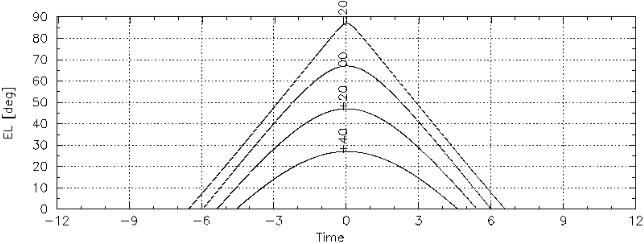
Fig.1(b): Time versus elevation angle diagram for sources at Declination = -20, 0, +20, and +40 deg.
| Date | Sunset | Sunrise |
|---|---|---|
| 2018/06/01 | 10:00 | 23:20 |
| 2018/07/01 | 12:00 | 01:20 |
| 2018/08/01 | 14:00 | 03:20 |
| 2018/09/01 | 16:20 | 05:00 |
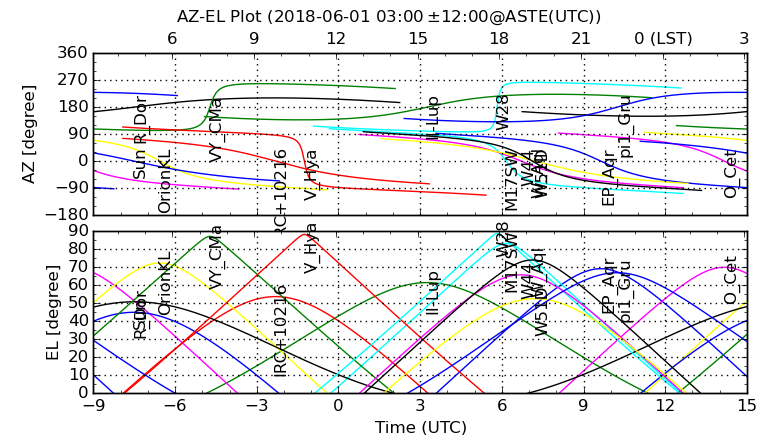
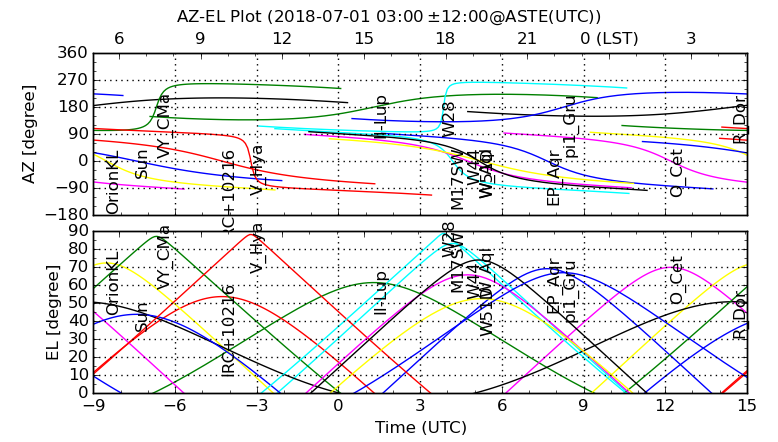
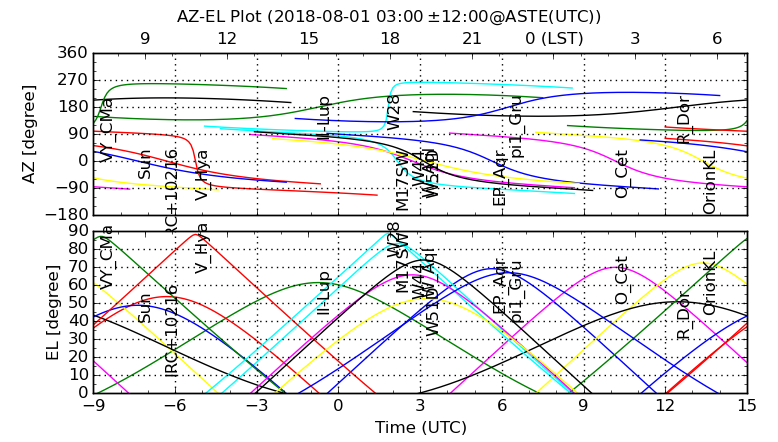
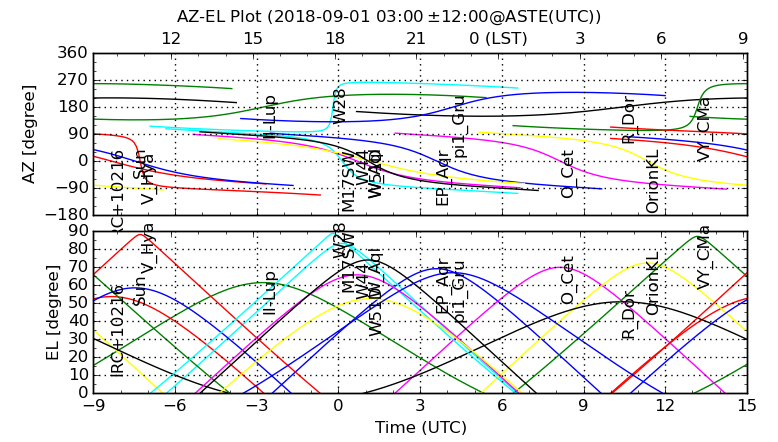
Fig.2: Azimuth versus elevation diagram for several selected standard/calibration sources and the Sun.
2. Estimation of observing time
- For position switch observations
-
- An rms noise level dTA* of the spectrum after integration time tinteg is estimated with the following equation:
 ,
,
where Tsys is the system noise temperature (SSB) in Kelvin, spec is the efficiency of the spectrometer, and df is a spectral resolution in Hz. The value of
spec is the efficiency of the spectrometer, and df is a spectral resolution in Hz. The value of  spec is 0.96 for the WHSF.
In addition, the values of a are sqrt(2) for single polarization and 1.0 for sum of both linear polarizations.
spec is 0.96 for the WHSF.
In addition, the values of a are sqrt(2) for single polarization and 1.0 for sum of both linear polarizations. - For instance, if we make a 60 sec integration with Tsys = 400 K (SSB), spectral resolution df = 1.0 MHz = 1.0 * 106 Hz (it corresponds to a velocity resolution dv = 0.87 km/s at f = 345 GHz or lambda = 0.87 mm), and single polarization, the resulting rms noise level will be dTA* = 76 mK in TA* scale.
- Note that this corresponds to 127 mK in TMB scale (if we adopt the main beam efficiency of 0.6 at 345 GHz for ASTE) or a flux density of 6.0 Jy for 22-arcsec beam (a typical beam size of ASTE at 345 GHz).
- See Appendix 1 of this document for intensity conversions between antenna/main beam temperatures and flux density.
- With this equation, estimate the required on-source integration time.
- The same amount of time will be spent for OFF point observations to subtract atmospheric emission. Furthermore, slew time of the telescope will also take into account as a overhead. In total, triple the required on-source integration time to estimate the total observing time, including OFF position observations and telescope slew time. For instance, in order to achieve an on-source integration time of 2 hours, you will need 6 hours in total (without other overheads, i.e., time for receiver tuning, pointing calibration, and standard source observation. See below about the estimation of these overheads).
- An rms noise level dTA* of the spectrum after integration time tinteg is estimated with the following equation:
- For On-The-Fly (OTF) observations
-
- Please consult with the ASTE-OTF web page.
- Please refer results of the latest tool of sensitivity estimation (otfaste.pl) in your technical justification. Note that outputs from the perl script are for single polarization, not dual polarizations.
- Another overheads other than target observations
-
- Receiver tuning: 5-10 minutes with a standard remote tuning.
- Pointing calibration observations: To measure and correct the pointing error, pointing observations (cross scan observations of a planet in a continuum observing mode or five point observations of a compact CO source in a spectroscopy mode) will be done every two hours during observations. It takes 10-20 minutes. If you are observing at the evening or morning (i.e., a rapid decrease or increase of the ambient temperature occurs), it is highly recommended to make more frequent pointing observations.
- Standard source observations: Galactic bright objects with known line strength will be observed as a standard source. It takes about 10-20 minutes, and we recommend to observe a standard source at least once per night.
Appendix
1. Intensity scale conversion from/to antenna temperature to/from flux density
- Antenna temperature, TA*
- TA* is related to the main beam temperature TMB with the following equation: TMB = TA* /ηMB, where ηMB is the main beam efficiency. In case of ASTE observations, ηMB at 350 and 490 GHz are, respectively, 0.6 and 0.45 for night time in winter.
- Main beam temperature, TMB
- TMB, is related to the flux density S as follows: S = 0.0735 λ-2 θ2 TMB, where λ is the observing wavelength in mm and θ is the beam size in arcsec. For instance, 1 K in TMB scale at 345 GHz (or 0.87 mm) with a 22-arcsec beam of ASTE corresponds to a flux density of 47 Jy. Similarly, TMB = 13.6 λ2 θ-2 S, where S is flux density in Jy/beam. For example, If we observe a point source (unresolved with the ASTE 22 arcsec beam at 345 GHz) with a flux density of 1 Jy will be observed as a 21 mK source in TMB scale, and therefore 13 mK in TA* scale in ASTE (adopting the main beam efficiency of 0.6).
